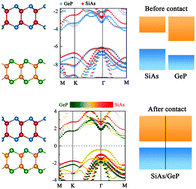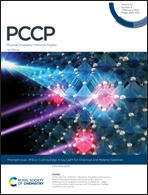A design rule for two-dimensional van der Waals heterostructures with unconventional band alignments†
Abstract
The energetic alignment of band edges at the interface plays a central role in determining the properties and applications of two-dimensional (2D) van der Waals (vdW) heterostructures. Generally, three conventional heterojunction types (type-I, type-II, and type-III) have widely been investigated and used in diverse fields. Unconventional band alignments (type-IV, type-V, and type-VI) are, however, hitherto unreported in the vdW heterostructures. We find that 2D binary semiconductors composed of group IV–V elements manifest a similar electronic structure, offering in principle the possibility of designing heterostructures with novel band alignments due to the hybridization of band-edge states. We first show here that a 2D SiAs/GeP heterostructure exhibits a type-VI band alignment, which is induced by the interlayer pz orbital hybridization, and a transition of band alignment from type-VI to type-V occurs when strain or electric field is applied over a critical value. The unconventional band alignments and their transition natures enable broad application of these vdW heterostructures in special opto-electronic devices and energy conversion.



 Please wait while we load your content...
Please wait while we load your content...